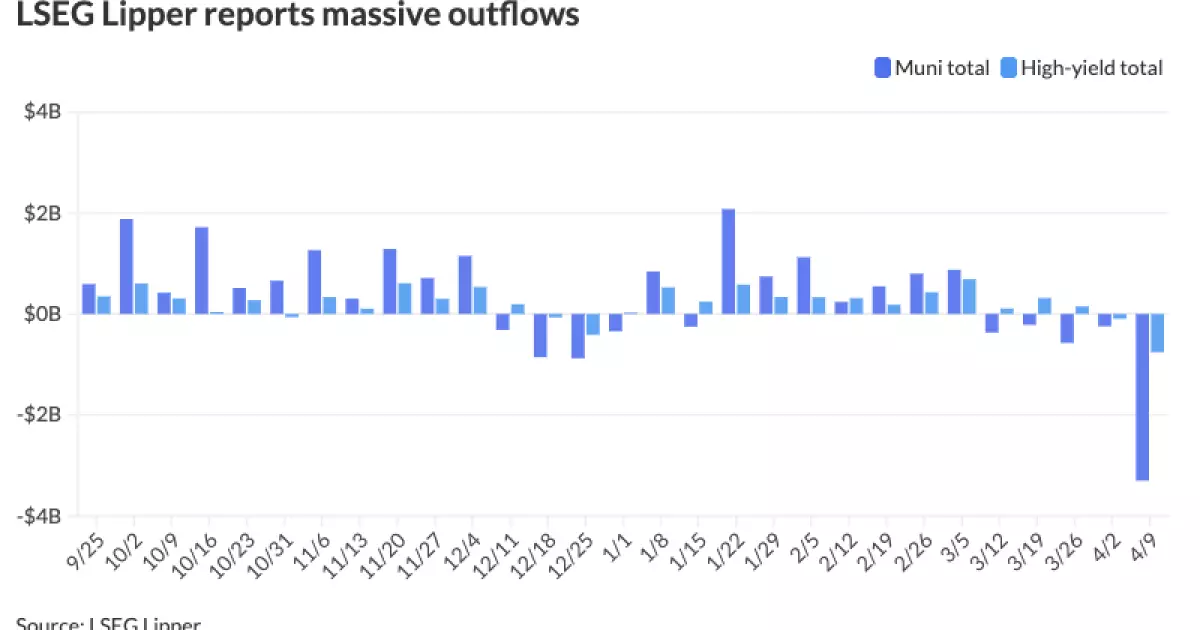The municipal bond market has recently experienced tumultuous fluctuations, culminating in a remarkable $3.3 billion outflow from municipal bond mutual funds—the most significant figure since June 2022. While the municipal bonds managed to rally hard after a rough preceding day, it feels rather deceptive to celebrate a recovery predicated on external factors, like the tariff extension and a seemingly favorable consumer price index (CPI). This recovery is akin to a mirage in a desert, masking underlying weaknesses in our economy that could rear their heads at any moment.
This outflow raises legitimate concerns about the health of the municipal bond market and the confidence investors have in both the economic conditions and the policy environment. The apparent volatility is alarming and suggests that the market is precariously balanced on the edge of uncertainty. Financial analysts have painted mixed signals: they praise the short-lived recovery while making it clear that significant turbulence may be on the horizon if major economic policies change.
The Impact of External Economic Factors
Municipals’ short-lived resurgence is primarily fueled by the news of the 90-day tariff extension, which was, surprisingly, received quite positively. But let’s not kid ourselves; while some view this as a stabilizing factor, it might merely be a temporary comfort blanket for investors amidst rampant uncertainty. With the U.S.-China tension rising, it feels almost reckless to assume that everything will remain stable, especially when global political dynamics can shift faster than public opinion.
In light of the recent CPI report indicating only a 2.4% increase, slightly softer than the anticipated 2.6%, some market participants seized upon the release. They argue it’s a sign of easing inflation pressure and a platform from which to launch a concerted recovery. This is shaky reasoning; the economy is not fully out of the woods, and anticipating trends based solely on one data point is fraught with peril.
Investors often take solace in short-term gains but must be cautious of the broader landscape. We are teetering on the brink of economic policy changes that could dramatically shift interest rates and put renewed pressure on municipal bonds; thus, any optimism should be tempered with vigilance.
Investor Sentiment and Volatile Waters
Market participants have expressed renewed confidence in buying bonds, reflecting a shift from the panic observed earlier in the week. Mark Paris from Invesco indicated that the recovery is not only tenuous but also contingent on continued market stability—a precarious balancing act that could falter at any given moment. The sentiments are more titillating than reassuring; there’s a palpable fear that investors could pull back again if economic news skews negative.
Interestingly, the market dynamics highlight a herd mentality, where confidence can lead to swift decision-making fueled by the right headlines. It may feel comforting for investors to jump back in amid this mini-recovery, but it’s critical to remain grounded in fiscal reality. Analysts like Michael Pietronico urge that while this “minor recovery” may signal the worst could be over for now, it’s hardly time to breathe easy. The tariff debates will undoubtedly continue to introduce instability into the market, limiting any potential for a sustainable recovery.
Inflationary Headwinds and Muni’s Continued Struggles
An essential factor weighing heavily on the municipal bond market is the persistent inflationary environment. Even with a slightly lower CPI, the notion that inflation is easing remains speculative at best. Investors need to remain particularly cautious as lawmakers grapple with tax policy uncertainty. These combined headwinds have dealt a severe blow to investor confidence, which is already fragile.
It is telling that outflows haven’t solely stemmed from tariff-induced volatility; they predate such uncertainties. As esoteric factors like interest rates fluctuate wildly, the municipal market is left to grapple with severe headwinds generated from both sides—high supply and muddled policy clarity. The worrying trend of consistent outflows signals a troubling lack of demand; as inflation remains a specter hovering over fiscal planning, municipal bonds could become a tougher sell to a wary public.
The Road Ahead: Cautions Amidst Celebrations
While the current economic conditions may appear manageable, the waiting game is fraught with risk. Municipal bond investors would do well to remain skeptical of quick recoveries based solely on temporary flexibilities in the market. The road ahead promises obstacles, driven by the tariff policy and most importantly, the looming specter of inflation.
Amid these utterly unpredictable circumstances, it is vital to take a measured approach and remain grounded in investment philosophies rooted in fiscal discipline and a keen understanding of the evolving political landscape. As we navigate through this paradigm stress test, decision-making will require a keen assessment of the delicate balance between risk and potential reward—a balancing act that will define the municipal bond market for months, if not years, to come.

